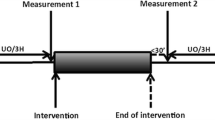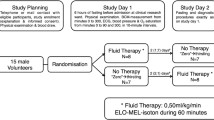Summary
Intrathoracic blood volume was increased by prolonged immersion in thermo-indifferent (34δ C) water. Urinary excretion patterns of free water and electrolytes during immersion were compared with those for an identical period of the previous day when the subjects were performing routine activity. Plasma volume changes during immersion were compared with the concomitant urine volume which under these conditions can be equated with total fluid loss. The nature of the immersion diuresis depended on the state of hydration. Normally hydrated subjects showed a rise in free water clearance whereas a hydropenic group increased urine volume by an augmentation of osmolar clearance. Sodium excretion during immersion rose from 118±48 (SD) to 180±51.7 (SD) μeq./h×kg in normally hydrated subjects (p>0.05) and from 66.8±22.5 (SD) to 152±43.3 (SD) μeq./h×kg (p<0.01) in the hydropenic group.
Immersion led to plasma volume reduction in all cases. Plasma volume reduction constituted a much greater percentage of the urine volume in hydropenic subjects (98.8±35.4 (SD)%) than in the normally hydrated ones (19.3±8.56 (SD)%). It is concluded that engorgement of the intrathoracic volume-sensitive vascular areas may not only lead to increased fluid elimination by the kidney but at the same time to a shift of fluid from plasma into the interstitial space. Both effects serve the homeostatic control of blood volume.
Similar content being viewed by others
References
Bazett, H. C.: Studies on the effects of baths on man. I. Relationship between the effects produced and the temperature of the bath. Amer. J. Physiol.70, 412–429 (1924).
—, Thurlow, S., Crowell, C., Stewart, W.: Studies on the effects of baths on man. II. The diuresis caused by warm baths, together with some observations on urinary tides. Amer. J. Physiol.70, 430–452 (1924).
Boylan, J. W., Antkowiak, D. E.: Mechanism of diuresis during negative pressure breathing. J. appl. Physiol.14, 116–120 (1959).
Carswell, F., Hainsworth, R., Ledsome, J. R.: A diuretic response to left atrial distension in the isolated perfused kidney. J. Physiol. (Lond.)195, 20–21 P (1968).
Cox, J. R., Davies-Jones, G. A. B., Leonard, P. J., Singer, B.: The effect of positive pressure breathing on urinary aldosterone excretion. Clin. Sci.24, 1–5 (1963).
Eckert, P.: Unpublished results.
Gamble, J. L.: Chemical anatomy, physiology and pathology of extracellular fluid. 6th ed., p. 93. Cambridge, Mass.: Harvard University Press 1954.
Gauer, O. H.: Osmocontrol versus volume control. Fed. Proc.27, 1132–1136 (1968).
Gauer, O. H., Henry, J. P.: Circulatory basis of fluid volume control. Physiol. Rev.43, 423–481 (1963).
—— Sieker, H. O., Wendt, W. E.: The effect of negative pressure on urine flow. J. clin. Invest.33, 287–296 (1954).
Graveline, D. E., Duane, E., Jackson, M. M.: Diuresis associated with prolonged water immersion. J. appl. Physiol.17, 519–524 (1962).
Henry, J. P., Gauer, O. H., Reeves, J. L.: Evidence of the atrial location of receptors influencing urine flow. Circulat. Res.4, 85–90 (1956).
Hertig, B. A., Riedesel, M. L., Belding, H. S.: Sweating in hot baths. J. appl. Physiol.16, 647–651 (1961).
Hong, S. K., Ting, E. Y., Rahn, H.: Lung volumes at different depths of submersion. J. appl. Physiol.15, 550–553 (1960).
Hunt, N. C.: Positive pressure breathing during water immersion. Aerospace Med.38, 731–735 (1967).
Ingraham, R. C., Wiggers, H. C.: Alkalinizing agents and fluid priming in hemorrhagic shock. Amer. J. Physiol.144, 505–512 (1945).
Kaiser, D., Linkenbach, H. J., Gauer, O. H.: Änderungen des Plasmavolumens des menschen bei Immersion in ein thermoindifferentes Wasserbad. Pflügers Arch.308, 166–173 (1969).
Linder, A.: Statistische Methoden. 3rd ed. Basel-Stuttgart: Schwabe 1960.
McCally, M.: Plasma volume response to water immersion. Implications for space flight. Aerospace Med.35, 130–132 (1964).
McCance, R. A.: Experimental sodium chloride deficiency in man. Proc. roy. Soc. B119, 245–268 (1936).
Moore, F. D., Olesen, K. H., McMurrey, J. D., Parker, H. V., Ball, M. R., Boyden, C. M.: The body cell mass and its supporting environment. Body composition in health and disease. Philadelphia-London: W. B. Saunders Comp. 1963.
Murdaugh, H. V. Jr., Sieker, H. O., Manfredi, F.: Effect of altered intrathroracic pressure on renal hemodynamics, electrolyte excretion and water clearance. J. clin. Invest.38, 834–842 (1959).
Öberg, B.: Effect of cardiovascular reflexes on net capillary fluid transfer. Acta physiol. scand.62, Suppl. 229 (1964).
Schrier, R. W., McDonald, K. M., Marshall, R. A., Lauler, D. P.: Absence of natriuretic response to acute hypotonic intravascular volume expansion in dogs. Clin. Sci.34, 57–72 (1967).
Segar, W. E., Moore, W. W.: The regulation of antidiuretic hormone release in man. I. Effects of change in position and ambient temperature on blood ADH levels. J. clin. Invest.47, 2143–2151 (1968).
Sieker, H. O., Gauer, O. H., Henry, J. P.: The effect of continuous negative pressure breathing on water and electrolyte excretion by the human kidney. J. clin. Invest.33, 572–577 (1954).
Smith, H. W.: Salt and water volume receptors. Amer. J. Med.23, 623–652 (1957).
Sonnenberg, H., Pearce, J. W.: Renal response to measured blood volume expansion in differently hydrated dogs. Amer. J. Physiol.203, 344–352 (1962).
Author information
Authors and Affiliations
Additional information
A preliminary report of this work appeared in abstract form in Pflügers Arch. ges. Physiol.300, 41 (1968).
This study was supported by Contract F 61052-68-C-0069 of the USAF School of Aerospace Medicine, European Office of Aerospace Research (OAR), U.S. Air Force, and a Grant from the Deutsche Ibero-Amerika Stiftung, Hamburg, Germany.
Rights and permissions
About this article
Cite this article
Behn, C., Gauer, O.H., Kirsch, K. et al. Effects of sustained intrathoracic vascular distension on body fluid distribution and renal excretion in man. Pflugers Arch. 313, 123–135 (1969). https://doi.org/10.1007/BF00586240
Received:
Issue Date:
DOI: https://doi.org/10.1007/BF00586240
Key-Words
- Expansion of Intrathoracic Vascular Volume
- Water and Electrolyte Balance
- Immersion Diuresis
- Blood Volume Control
- Extracellular Fluid Distribution




